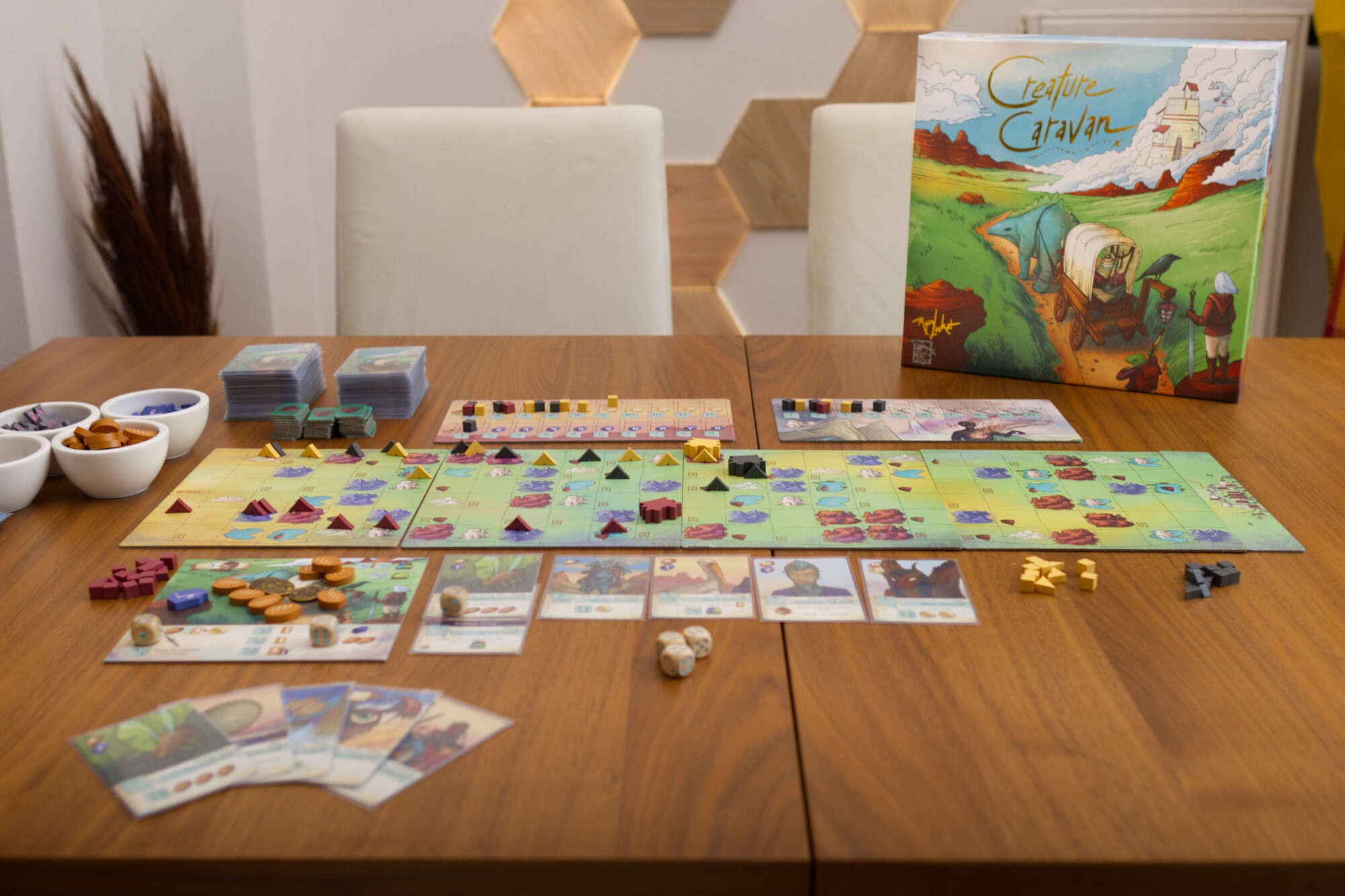Ryan Laukat (and in extension Red Raven Games) is best known for his story-infused big box titles such as Sleeping Gods, Near & Far, or Empires of the Void II. The degree in which story is the driving factor varies from game to game – from being at the forefront in Sleeping Gods to pretty much optional in Now or Never – but it on first glance seems to be as essential a factor as the lovely painterly art style that Ryan has become known for. It therefore isn’t surprising that many are not even aware of Ryan’s lighter, smaller box titles such as the excellent Roam, a pattern-placement area majority game that plays in 20-30 mins and I’ve come to grow quite fond of over time.
When Creature Caravan was announced, it took a number of people by surprise because it broke the familiar mould: No story? Different art style? Big box but lighter game? Simultaneous play? Truth be told, I myself was torn whether I should back it or not and only decided to jump on the bandwagon after seeing a very enthusiastic preview of the Dice Tower crew that got me curious. The main thing I couldn’t figure out was: why were they raving about this game despite it seeming so very multiplayer-solitaire? Let’s dig into it …
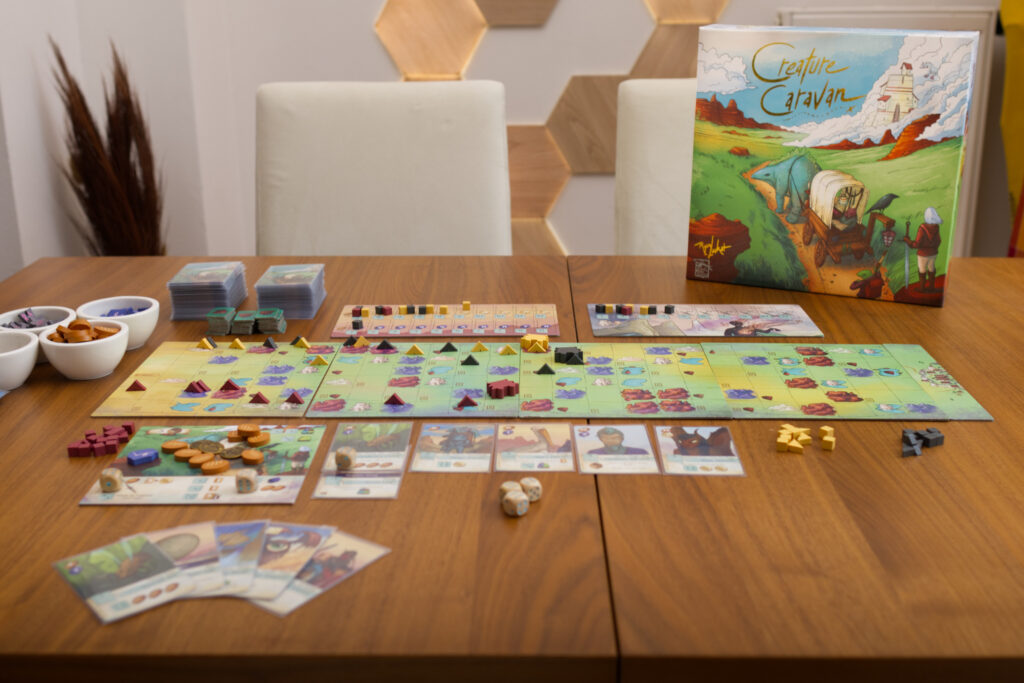
Setup
Upon opening the box, my initial impression was that there is a surprising amount of things in it. Part of it can be explained by it being the GameFound Deluxe edition, so there are components for up to six players as opposed to the standard four in the retail edition and a lot of components exist both in the cardboard retail version as well as their upgraded variant. Even taking that out of the equation, there are many things going on: caravans and tents, markets and zombies, chests and food, …
Setup itself though is done rather quickly. Arrange the four double-sided map boards in a long straight and add the terminal piece representing the city of Eastry at the end. Shuffle the creature cards and give each player a starting hand of eight as well as a – somewhat unusually large – caravan token that represents their location on the map plus tents and cubes in their player color. Each player choses a starting row in the first column of the map and that’s pretty much it except for pouring resources into some bowls or piles. The only starting resource each player gets is a single coin which almost feels like a tease as if the game says “this might be the only coin you’ll be seeing for a while”.
The Turn
Somewhat unexpectedly, there is no income phase in Creature Caravan. Instead, each of the twelve turns of the game starts by all players rolling their dice and then simultaneously figuring out on which of their actions they want to use them. To start with, each player only has a couple of standard actions on their player board but additional ones are gained by adding creatures to their caravan.
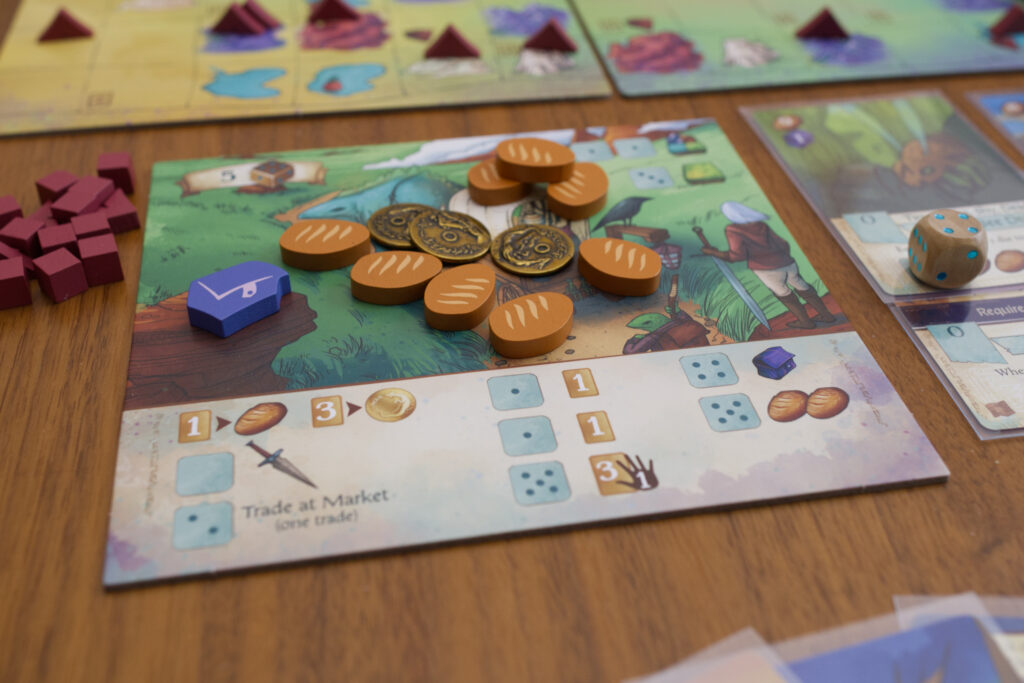
The general mechanism is that most actions show a die value that is the minimum required to trigger the action. For example if the action shows a pip value of 3, any die showing a 3 or higher can be used there. The die is placed on the spot to mark it has been used and cannot be used again in the same turn. This obviously makes higher value dice more valuable than lower ones and to somewhat combat the randomness of the initial die roll, each player is allowed to do one complete re-roll if they chose to do so.
There are four elementary resources in Creature Caravan: bread (which is the main currency to pay for cards), coins and bags (sometimes used for purchases, often used for trading), and the cards themselves. Let’s start with cards. Each card shows a creature that can join the caravan and provide new actions or permanent benefits. As stated before, each player starts with an initial hand of eight and there is no income phase. So if a player wants to get new cards – and boy will they want to – they have to spent actions to get them. On the player board, a one can be converted into a single card where a five allows drawing three and keeping on of them. The latter becomes crucial because of how the various cards interact.
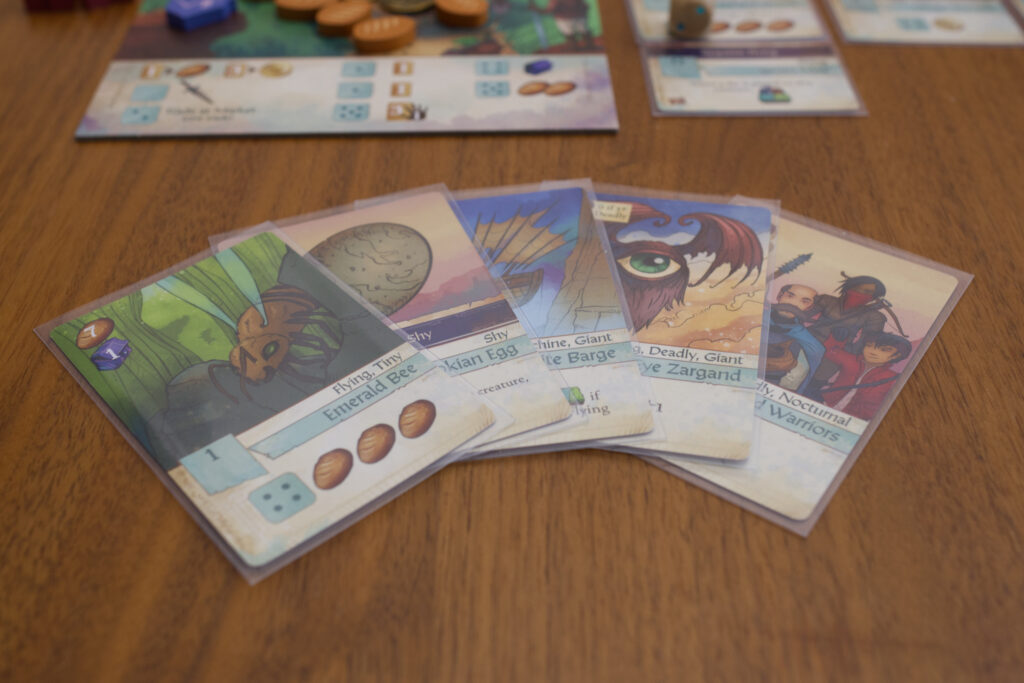
In the top-left corner, each card shows the cost to purchase (=play) the card, usually consisting of a sizeable number of bread and on occasion some additional bags or coins. Each card also shows the action and victory points it provides where the latter is often connected to some condition such as having four of a certain type of card in own’s caravan. This refers to both classification tags shown on the cards (e.g. flying, giant, shy) as well as the name of some cards. There are also cards that get cheaper when certain other cards are already part of the caravan or whose action gets stronger depending on who else is part of the gang. This element reminded me very much of Fantasy Realms because in both games achieving synergy with your cards is of the very essence. Depending on the cards one draws, a player might go for a group of fighters that can brush away anything that stands in their way or rather a rag tag gang of tiny creatures that produces obscene amounts of resources. There is no hand limit at all, but only up to twelve creatures can be included in the caravan. Once all slots are filled up, that’s it.
The creature deck is quite large and gathering cards that match each other seems a daunting task at first, but once players get their economy going, there is quite a healthy churn through the deck. One major aspect that helps is that any card can be discarded for a bread, coining the expression “you are bread” in my play group whenever one draws yet another card that is simply useless for their caravan. So getting back to resources, cards in hand are actually a more flexible version of bread and drawing one that’s not that useful isn’t as bad as it might seem.
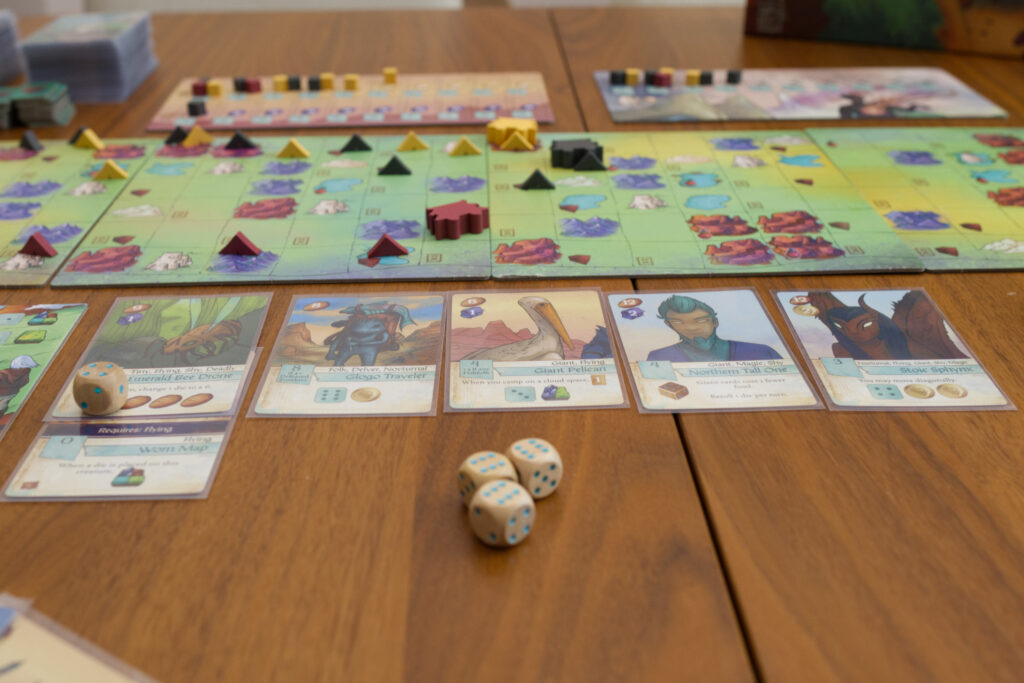
Movement & Fighting
Besides gaining resources to buy more creature cards, dice are also used to travel along the map towards the safe haven of Eastrey (the city at the end of the board). Storywise, players are fleeing hordes of ember zombies though mechanically we found that actually reaching Eastrey is not that essential, more on that later.
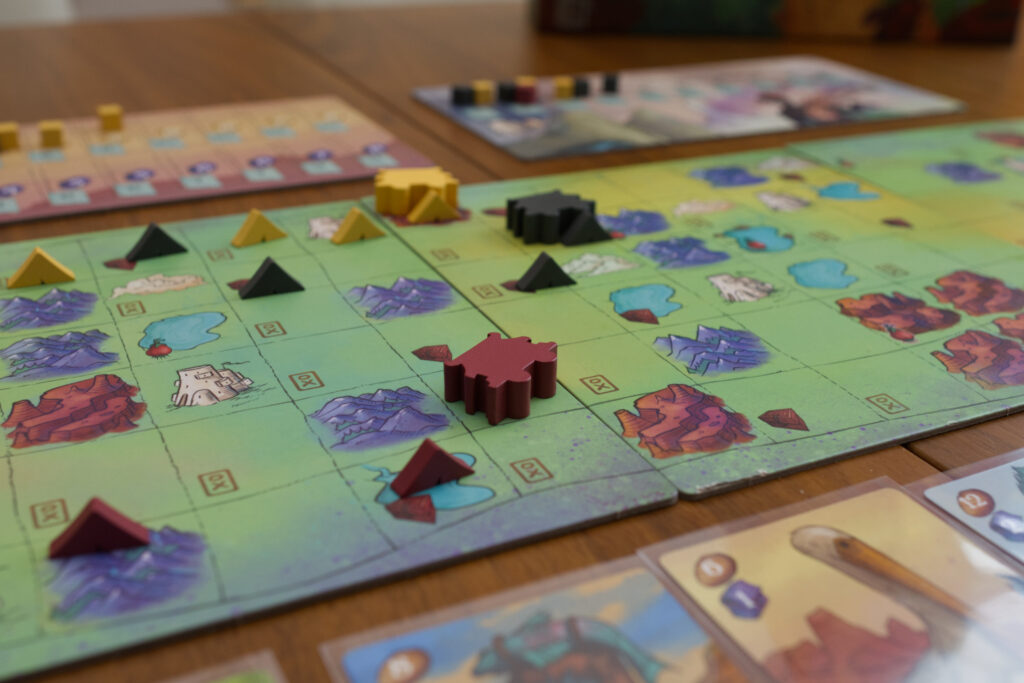
Some of the actions both on the player boards as well as on certain creature cards show a die value next to one or more types of terrain. When activating the action, the player’s caravan token can be moved one step up, down, or towards Eastrey if the target square is of the terrain types shown on the action. Grassland is the easiest terrain to pass, with red canyons, blue mountains, and lakes usually requiring higher die values or special creature cards.
There are some end-of-round effects that are triggered based on the square the caravan will end up on. Towers allow a player to draw three cards for free, fruits allow a player to reduce the required minimum pip value on a card, and chests award 1-2VP plus a resources.
Some of the squares are marked with an OX symbol that represents the player has to either take a penalty token (worth -1VP) or fight an ember zombie as they move into the square. This is done by placing a die on an action showing a sword which gives the player combat points equal to the pip value of the die. Multiple such action spots can be combined to get even more combat points. The player then picks a column on the zombie board that shows that many swords (or less) and places a cube in the top spot of that column. Each player can fight each strength of zombie only once per game, but players are also in competition with each other … which might sound weird keeping in mind the whole turn is executed simultaneously by all players.
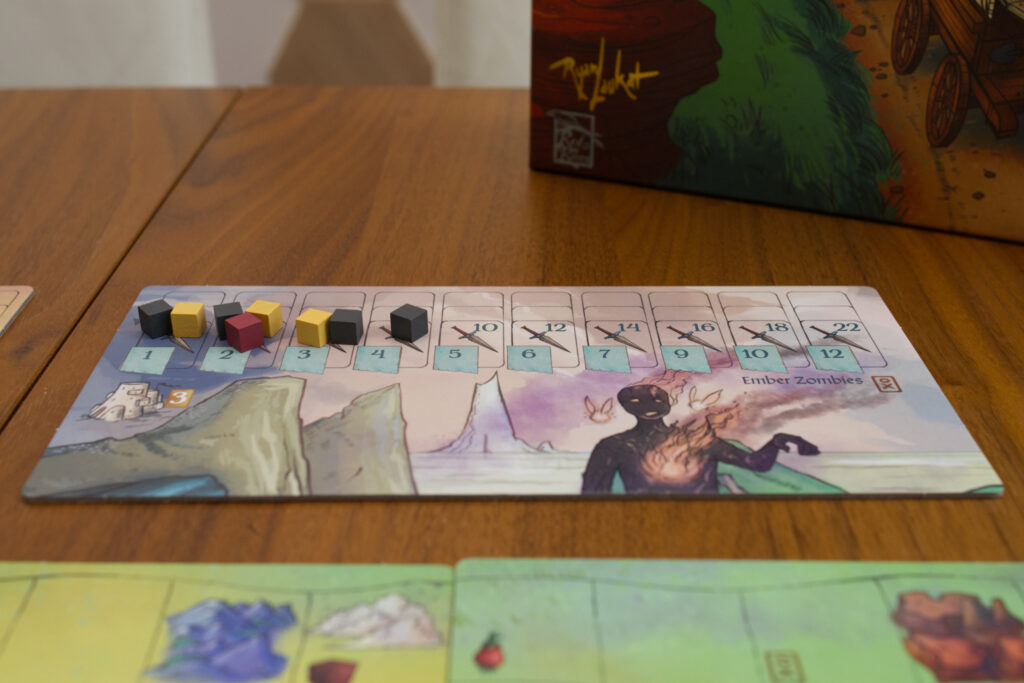
Creature Caravan solves this by allowing other players to fight the same zombie unless a player cube has reached the third and last step in a column. At the end of each turn, all cubes are moved down one step, effectively allowing other players to fight a zombie in the same or in the following turn but no later than that. This actually works quite nicely as it puts pressure on the other players, having to fight stronger and stronger zombies if they don’t hurry up. Overall though, since fleeing from a fight costs just -1VP, simply rushing through zombie squares is a very viable option. But fighting especially the higher strength zombies can be a quite sizeable source of victory points.
Trading
Trading with the market works in a similar way. If a player manages to get a sizeable production of either coins or bags going, they can use the trade action on their player board to do a single trade. All trades convert either coins or bags into bread and VP, with the amounts required increasing naturally as other players will have snatched up the cheaper (=more easily doable) trades. Similar to fighting, trading is something a player has to invest in to be a viable strategy. Without the proper creatures in your caravan, the few coins/bags players can produce with standard actions are better saved to pay for the stronger creature cards that require them as payment.
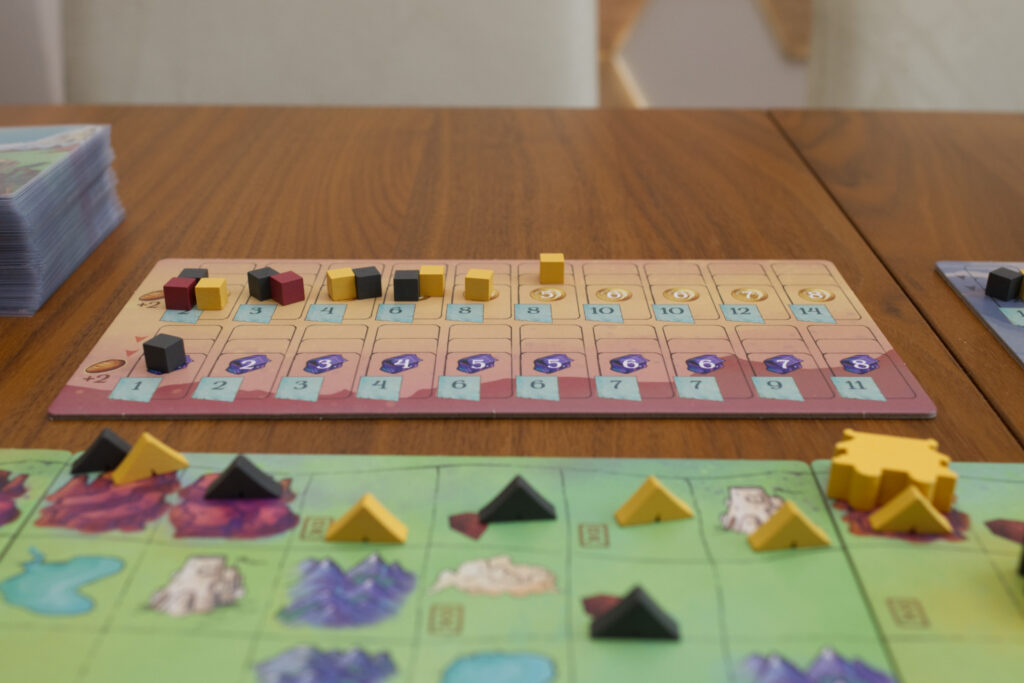
Game End
The game ends after the twelfth turn. This is tracked by each player placing a tent on whatever place their caravan is at the end of a turn. They don’t have to move each turn, but players will receive VP for the number of different squares they have tents on. Additional VP are awarded the closer they got to Eastrey, zombies they fought, trades they made, and of course the VP printed on the creature cards in their caravan.
In my playgroups, we have found that collecting at least some creatures that award 8 or more VP based on some condition (e.g. have 5 magic creatures) is of essence here. Reaching Eastrey is surprisingly not as relevant as the story might suggest. A friend of mine has been highly successful in not even leaving the first board of the map and instead just moving far enough to trigger the next combat, going for the high value zombies as soon as possible. Trading seems to be a middle ground between going purely for strong creature combinations and making high amounts of VP in-game. In the end though, a lot depends on which cards you’ll draw. With the considerable size of the draw deck, it doesn’t make any sense to set your mind on a fighting strategy if the deck gives you cards for a heavy-trade strategy.
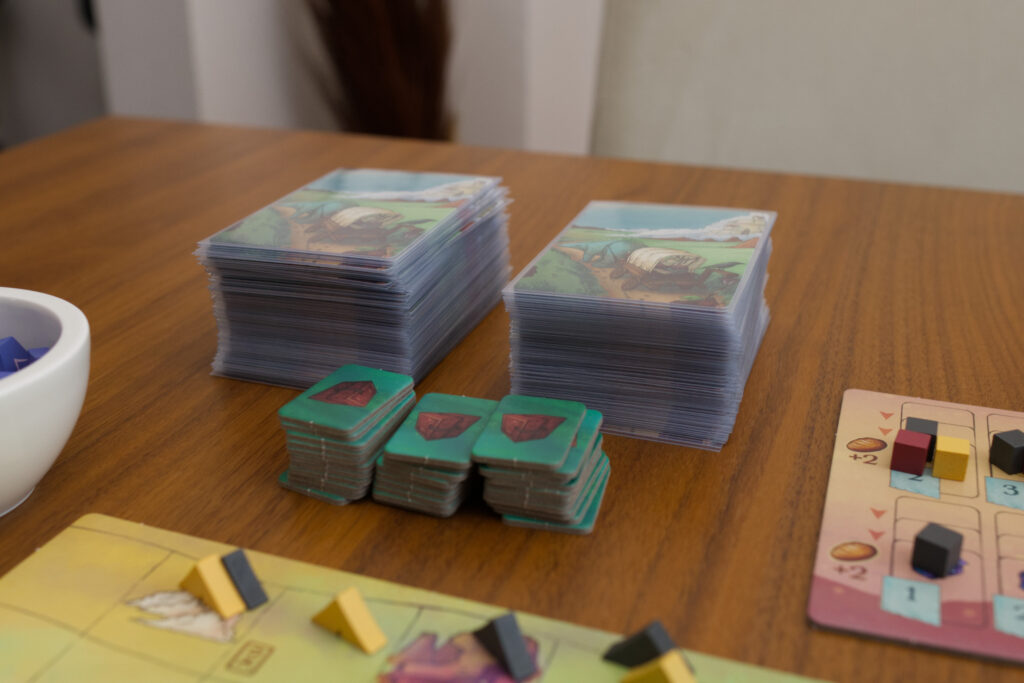
Deluxe Components & Expansion
I always enjoy the metal coins for Red Raven Games and this is the case here as well. Much more important though are the wooden bread and bag tokens since players are handling them all them time. All of the upgraded bits are not necessary to enjoy them game but provide a nice hand-feel. Just the ember zombie tokens are so rarely used that I wouldn’t have missed them if they weren’t there at all. And I almost forgot about the fruit tokens because I use them even less …
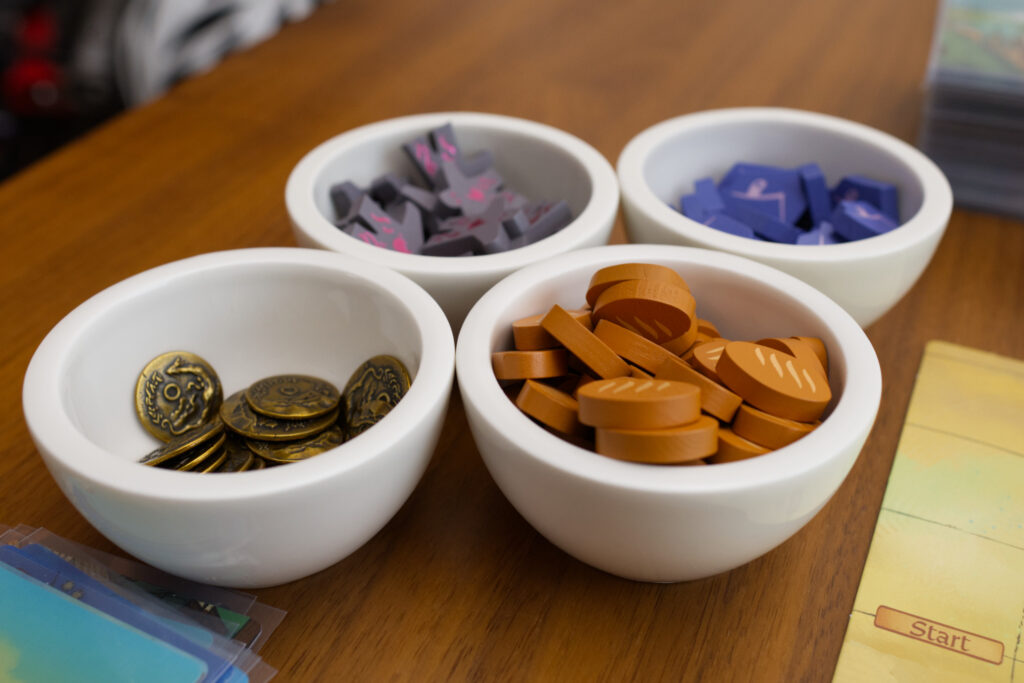
The other two reasons to get the deluxe edition are the additional fifth and sixth player (which I had no need for so far) and the included expansion which adds item cards. Items are a way to get around the twelve creature limit because they do not count against that. Instead, items are equipped to creature cards and require the creature to be of a certain type (e.g. the item has to be equipped to a giant). Often items will make a creature’s effect stronger or provide an additional benefit when the creature is triggered for its action.
While nice in theory, I personally found I prefer playing without the expansion and didn’t feel anything was missing when playing without it. Adding additional cards to the deck makes it more challenging to get good combos of your creatures going. The items also cost quite large amounts of bags which are hard to come by anyway and prevented me from playing stronger creatures.
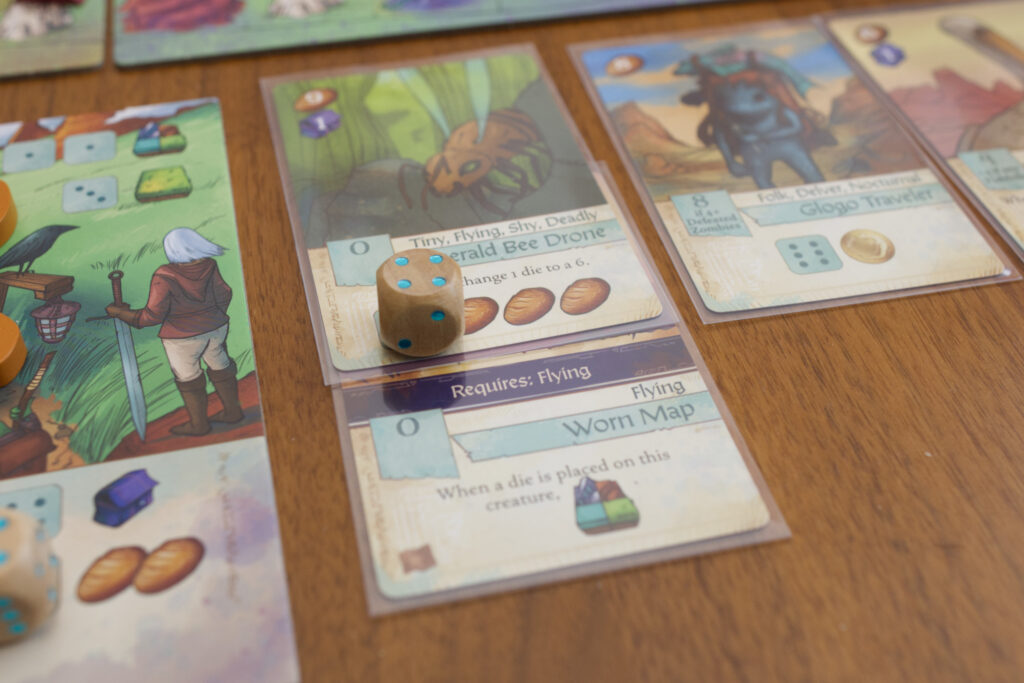
Solo Mode
Creature Caravan comes with a solo mode in the box, something I always appreciate. It works by flipping a player board to its back side and then rolling dice for the automa to perform various actions such claiming spots on the markte and zombie boards. While functional, I didn’t find it particularly exciting for two main reasons: one, Creature Caravan itself is missing any form of interaction on the map and two, the goal of the solo mode is to beat the somewhat random score the bot will achieve.
So I once again created my own solo mode which I call “Veteran Solo Mode” in honour of Ryan’s variant for Sleeping Gods: Distant Skies. It requires no additional components, adds two hard goals (achieve 100VP and reach Eastery) and some limited form of blocking on the map. Together, I found that a much more enjoyable solo experience. If you’re interested, you can find the rules in the solo section. With that solo mode, I really enjoyed Creature Caravan as a light but substantial game to chill after a long day at work. There is enough substance in finding good combinations of cards without being taxing in any way.
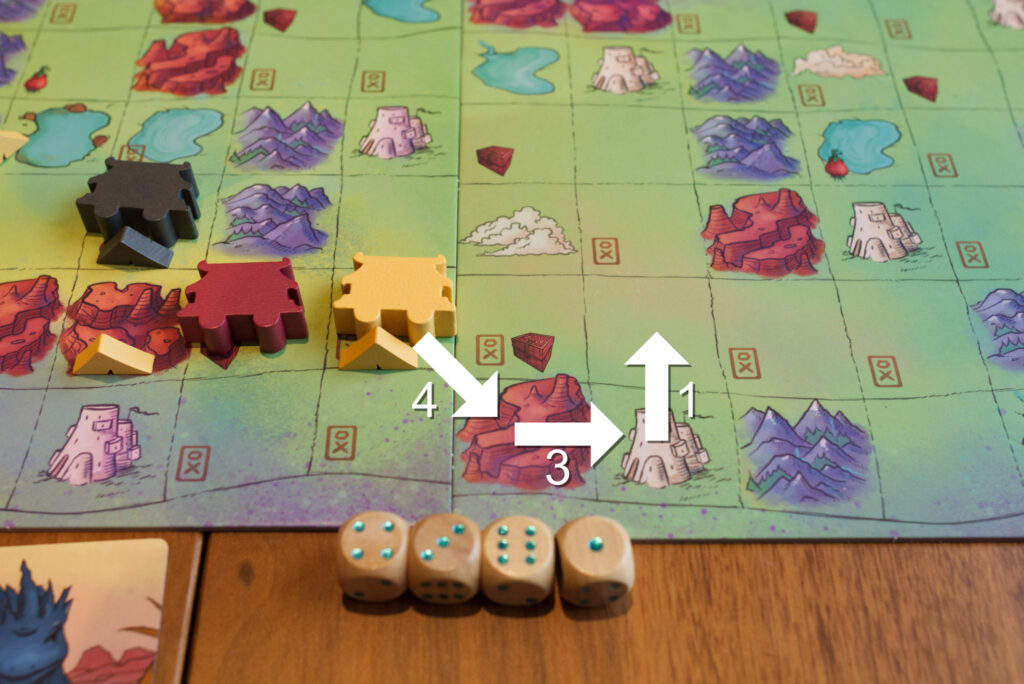
Conclusion
As I said in the beginning, Creature Caravan was a bit of an enigma for me going in. Why do people enjoy this game? As best as I can say, the simple answer to this is: because the core mechanism of using dice to trigger actions and trying to build synergies with creatures is just fun! Similar to playing Fantasy Realms, it’s immensely satisfying if one manages to gather 2-3 strong fighters and some other cards that give additional bonuses for defeated enemies. Or one manages to get tons of coins when the other players are struggling to get a single one. Looking at the size of the draw deck, I wouldn’t have thought finding matching cards would work, but the way how churning through cards has been implemented does work quite well. The randomness of the die rolls and higher values being clearly better than lower ones also rarely was an issue for me. Of course situations happen where you’re looking for one more magic creature and it simply won’t show up. In most cases though, that won’t cost you the win but rather some bigger miscalculation way earlier in the game.
If the creature card interaction is Creature Caravan’s biggest selling point, the map play unfortunately is its weakest. There is no interaction between players at all and actually reaching Eastrey often isn’t as beneficial as one would think considering the theme. The only true interaction players experience is via the market and zombie boards, but that might as well have been caused by some event system rather than other players. Each player has their own set of starting cards and draws directly from the deck, moves through the map without blocking, making it feel like each player is playing their own copy of the game and comparing scores at the end of it. This can create a great cozy vibe for players that like multiplayer solitaire, but for me it had more a feeling of a “oh, you’re also here?”.
The strange thing here is that the core system feels so strong, it must have been possible to implement more direct interaction and still keep the simultaneous play that makes Creature Caravan have such a nice flow. It just would have needed something that would make the game a common journey, not separate ones. Take for example a game where one player is going for a zombie-fighting strategy. You can’t take cards away because the other player draws directly from the deck. You can’t take zombie fighting away because zombie squares are not used up after the first fight. You can’t benefit from the other player clearing a path for you. The only thing you can try to influence what the other player is doing is to also do fighting and take away lucrative columns on the zombie board, but that requires you to by chance also draw cards suitable for fighting.
In a similar fashion, players can’t really pride themselves to have found the best combo because every player acts on a different portion of the deck’s cards. And since the game runs simultaneously, nobody will be able to tell whether a player was just lucky in what cards they drew or if they had done something particularly clever (or made some mistake without anybody noticing). It’s a strange feeling because there is much to love here. I really like the creature cards, the dice chucking, even the traveling on the map, as inconsequential as it often is. But as a friend of mine put it as we finished up our game of Creature Caravan: “I rather prefer playing WITH people when I take the time to play a board game”.
To sum it up: I can warmly recommend Creature Caravan for solo players, couples that enjoy multiplayer solitaire games, or potentially even families that want to avoid any conflict. The game is more fun to play than it might look on first glance, thanks to how neatly the creatures interact. For me personally though, I still hope that at one point there will be an official variant or expansion that makes it less of a solitaire journey. Something where players maybe use a common offering of creature cards instead of always drawing from the deck. Where players interact on the map, reaching Eastrey is more of importance, and rushing through zombies doesn’t just cost a negligible -1VP. There is so much potential here. I could also see another future iteration of this system that completely drops the map in favour of some other forms of interaction. We’ll see …
